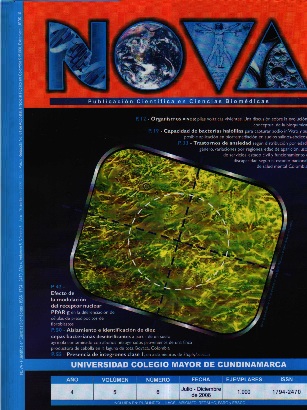Presencia de Integrones Clase 1 en Aislamientos de Staphylococcus epidermidis de las unidades de neonatología del Instituto Materno Infantil de Bogotá
Presencia de Integrones Clase 1 en Aislamientos de Staphylococcus epidermidis de las unidades de neonatología del Instituto Materno Infantil de Bogotá
NOVA by http://www.unicolmayor.edu.co/publicaciones/index.php/nova is distributed under a license creative commons non comertial-atribution-withoutderive 4.0 international.
Furthermore, the authors keep their property intellectual rights over the articles.
Show authors biography
Multiresistance to antimicrobial against Gram-positive bacteria, especially Staphylococcus epidermidis isa progressive problem in newborn-intensive care units. One of the recently described mechanisms of bacterialressistance is the presence of integrons and gene cassettes. There are more than 9 types of integrons, out ofwhich class 1 integron is the most frequently associated with strains causing hospital infections.
In this study, presence of class 1 integrons in Staphylococcus epidermis was determined as coming fromhemocultures and catheter points which caused nasocomial infection in newborn intensive care units of Ins-tituto Materno Infantil in Bogotá, Colombia. From the 46 studied strains, intl1 gene was detected in 21 ofthem (45.7%). This finding, pioneer in bacterial strains isolated in newborns, suggests the necessity to look or gene cassette which give resistance to the different anti microbial entities to define nosocomial infectiontreatment schemes caused by these microorganisms.
This is the first time mechanism of resistance to aminoglycoside and other antimicrobials in ColombianGram positive strains is studied. We suggest that it is important to carry out assays with gene cassette fordifferent antibiotics of nosocomial infection to provide a better treatment selection.
Article visits 163 | PDF visits 101
Downloads
- Ardic N, Sareyyupoglu B, Ozyurt M, Haznedaroglu T, Ilga U Investigation of aminoglycoside modifying enzyme genes in methicillin-resistant staphylococci: Microbiol Res. 2006;161:49-54.
- Cifuentes Y, Ruiz A, Leal A, Muñoz L, Herrera M, Jimenez L. Perfil microbiológico en asilamientos en Unidades Neonatales en un hospital de tercer nivel de Bogotá, Colombia. Rev. Salud Pública 2005; 7:191-205.
- Stockes H qnd Hall R. A novel family 9of potencially mobile DNA elements encoding site-specific gene integration finctions: integrons. Molec. Microbial. 1989; 3:1669-1683.
- Guillemont TrwB, the coupling protein involved in DNA transport during bacterial conjugation, is a DNA-dependent ATPase. Biochemistry 2005; 102:8156-8161.
- Gonzalez R, Mella S, Zemelman R, Bello H, Dominguez M. Integrones y cassettes genéticos de resistencia: estructura y rol frente a los antibacterianos. Rev. Méd. Chile, 2004; 132:619-626.
- Bennett, P and Howe T. Bacterial and bacteriophage genetics. In Topley & Wilson’s Microbiology and MicrobialInfections, 1998Vol. 2, Systematic Bacteriology, 9th edn, (Collier, L.,Balows, A. & Sussman, M., Eds), pp. 231–294. Arnold, London.
- Shi L, Zheng M, Xiao Z, Asakura M, Su J, Li L, Yamasaki S. Unnoticed spread of class 1 integrons in gram-positive clinical strains isolated in Guangzhou, China. Microbiol Immunol. 2006; 50:463-467.
- Nandi S, Maurer JJ, Hofacre C, Summers AO. Gram-positive bacteria are a major reservoir of Class 1 antibiotic resistance integrons in poultry litter. Proc Natl Acad Sci U. S A. 2004; 101:7118-7122.
- Nesvera J, Hochmannova J, and Patek M. An integron of class 1 is present on the plasmid Pcg4 front Gram positive bacterium Corynebacterium glutamicum FMS Microb. Lett. 1998; 169:391-395.
- Tauch A, Gotker S, Puhler A, Kalinowski J, and Thierbach G. The 27.8-Kb R-Plasmid pTET3 from Corynebacterium glutamicum encodes the aminoglycoside adenyltransferase gne cassette aadA9 and the regulated tetracycline efflux system Tet 33 flanked by active copies of the widespread insertion sequence IS6100. Plasmid 2002; 48:117-129.
- Collis CM, Hall RM. Expression of antibiotic resistance genes in the integrated cassettes of integrons. Antimicrob Agents Chemother. 1995; 39:155-162.
- Gonzalez G, Mella S, Zemelman R, Bello H and Dominguez Y. Integrones y cassettes genéticos de resistencia: estructura y rol frente a los antibacterianos. Rev. Méd. Chile, 2004, 132:619-626.
- Stokes HW, O’Gorman DB, Recchia GD, Parsekhian M, Hall RM. Structure and function of 59-base element recombination sites associated with mobile gene cassettes. Mol Microbiol. 1997; 26:731-45.
- Martinez-Freijo P, Fluid A, Schnitmitz F, Greck V, Verhoef J and Jones M. Class I integrons in Gram-negative isolates from different European hospital and association with decreased susceptibility to multiple antibiotics compounds. J. Antimicrob Cmeoter. 1998; 42:689-696.
- Fluit A and Schmitz F.-J. Resistance integrons and superintegrons, Clin. Microbio. Infec. 2004; 10:272-288.
- Pessoa- Silva C, Miyasaki C, de Almeida M, Kopelman B, Raggio R, Wey S. Neonatal late-onset bloodstream infection: attributable mortality, excess of length of stay and risk factors. Eur. J Epidemiol. 2002; 39:1034-1039.
- Cunha Ma de L, Lopes C, Rugolo L, Chalita L. clinical significance of coagulase-negative staphylococci isolated from neonates. J Pediatr (Rio J) 2002; 78:279-288.
- Cunha Mde L, Rugolo LM, Lopes CA. Study of virulence factors in coagulase-negative staphylococci isolated from newborns. Mem Inst Oswaldo Cruz. 2006; 101:661-668.
- Rowe-Magnus DA, Mazel D. The role of integrons in antibiotic resistance gene capture. Int J Med Microbiol. 2002; 292:115-125.
- Steve Rozen, Helen J. Skaletsky. 2000. Primer3 on the WWW for general users and for biologist programmers. In: Krawetz S, Misener S (eds) Bioinformatics Methods and Protocols: Methods in Molecular Biology. Humana Press, Totowa, NJ, pp 365-386. Source code available at http://fokker.wi.mit.edu/primer3/
- -----------------------------------------------------------------------
- DOI: http://dx.doi.org/10.22490/24629448.361






